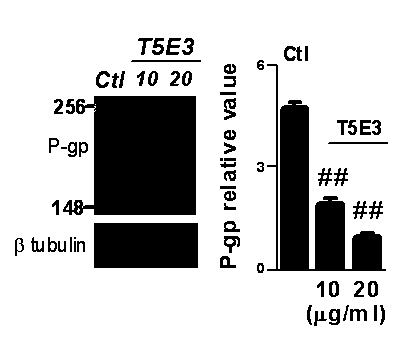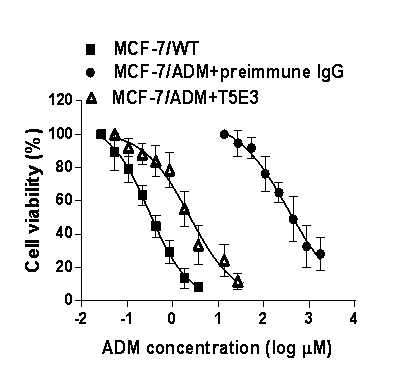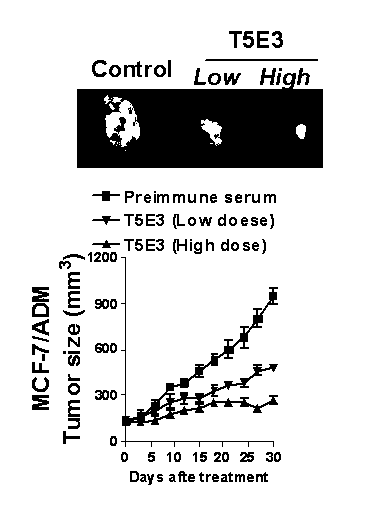Application of blocking antibody T5E3 to reversing of tumor multidrug resistance
A multi-drug resistance and antibody technology, applied in the direction of anti-tumor drugs, antibodies, anti-animal/human immunoglobulin, etc., to achieve good development prospects and non-toxic side effects
- Summary
- Abstract
- Description
- Claims
- Application Information
AI Technical Summary
Problems solved by technology
Method used
Image
Examples
Embodiment 1
[0026] Example 1 Down-regulation of P-gp expression in multidrug-resistant tumor cells by TRPC5 blocking antibody T5E3
[0027] experimental method:
[0028] MCF-7 / ADM was inoculated on a six-well plate at a density of 300,000 cells per well. After culturing for 12 hours, different concentrations of T5E3 (10 μg / mL, 20 μg / mL) were added to each well, and serum IgG from New Zealand rabbits before immunization was used.
[0029] As the control group (Ctl), the cells were cultured routinely, and the cells in each well were collected after 24 hours. According to the conventional operation method, Western blot was used to detect the expression of P-gp before and after TRPC5 was inhibited.
[0030] Tubulin was used as an internal reference, the primary antibody for incubation with βtubulin was βtubulin antibody (SC-9104), and the secondary antibody for incubation was horseradish peroxidase-labeled goat anti-rabbit IgG (H+L).
[0031] Experimental results:
[0032] See the experime...
Embodiment 2
[0034] Example 2 Reversal effect of TRPC5 blocking antibody T5E3 on multidrug resistance of tumor cells in vitro
[0035] experimental method:
[0036] MCF-7 / ADM and MCF-7 / WT were inoculated on 25cm2 When the MCF-7 / ADM confluence was 80%, TRPC5 blocking antibody T5E5 was added at 20 μg / mL, and New Zealand rabbit pre-immune serum IgG was used as the control group, and the cells were routinely cultured, and after 24 hours Collect the above-treated MCF-7 / ADM and untreated MCF-7 / WT, inoculate in a 96-well plate at a density of 7000 cells per well, add doxorubicin according to the concentration gradient after 24 hours, and culture for 48 hours Afterwards, the drug sensitivity of the cells was detected by MTT assay.
[0037] Experimental results:
[0038] See the experimental results figure 2 . Depend on figure 2 It can be seen that the sensitivity of multidrug-resistant tumor cells (MCF-7 / ADM) to doxorubicin was significantly lower than that of wild-type tumor cells (MCF-7 / W...
Embodiment 3
[0039] Example 3 Reversal effect of TRPC5 blocking antibody T5E3 on multidrug resistance of tumor cells in vivo
[0040] experimental method:
[0041] The TRPC5 blocking antibody T5E3 was injected every three days at the tumor site of the drug-resistant tumor-bearing mice, and divided into two experimental groups: the middle and low dose group (2 μg), and the high dose group (4 μg). New Zealand rabbits were immunized Pre-serum IgG was used as the control group; ADM (4 mg / kg mouse weight) was continued to be injected on the second day after each injection of T5E3, and the tumor was removed at different time periods, and the tumor volume was taken and measured for a total of 30 days.
[0042] Experimental results:
[0043] See the experimental results image 3 . Depend on image 3 It can be seen that the TRPC5 blocking antibody T5E3 can significantly inhibit the growth of drug-resistant tumors in a dose-dependent manner. The experimental results show that T5E3 has an obviou...
PUM
 Login to View More
Login to View More Abstract
Description
Claims
Application Information
 Login to View More
Login to View More - R&D
- Intellectual Property
- Life Sciences
- Materials
- Tech Scout
- Unparalleled Data Quality
- Higher Quality Content
- 60% Fewer Hallucinations
Browse by: Latest US Patents, China's latest patents, Technical Efficacy Thesaurus, Application Domain, Technology Topic, Popular Technical Reports.
© 2025 PatSnap. All rights reserved.Legal|Privacy policy|Modern Slavery Act Transparency Statement|Sitemap|About US| Contact US: help@patsnap.com



